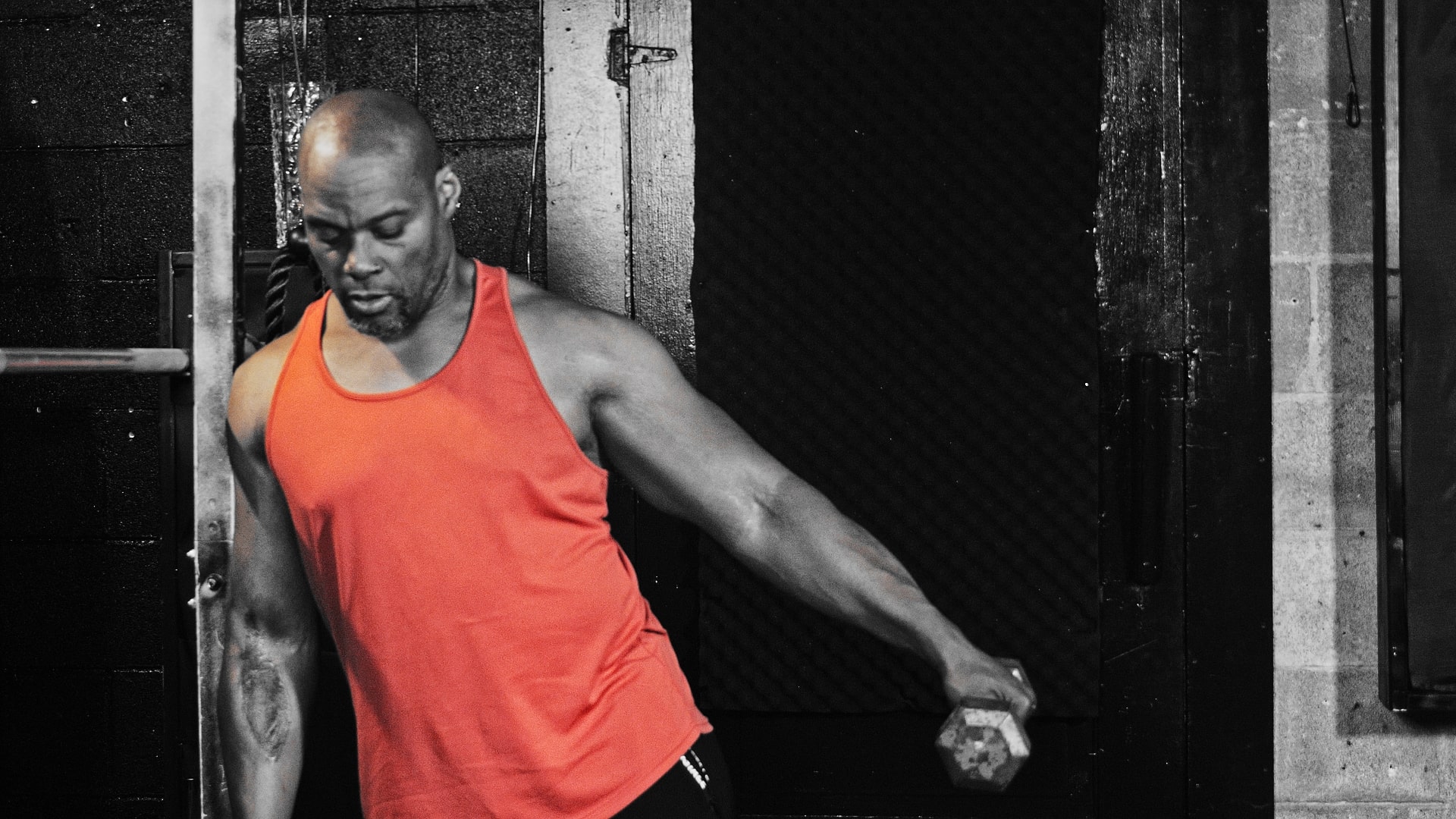Mission Jacked.com
The Leaning
Lateral Raise -
A Great Way To Cap off The Deltoids
Introduction
As an intermediate or advanced lifter, you may have done your fair share of the standard Lateral Raise. The Leaning Lateral Raise, aka the leaning dumbbell raise, is a great add-on to any advanced resistance training program and another way to place tension on the medial deltoid muscle. Compare this lateral raise variation to the standard dumbbell lateral raise, you will notice that this exercise movement places the lateral deltoid head under tension through a greater range of motion.
There are two types of Leaning Lateral Raise movements. The first variation is where you lean at an angle against a wall or side onto an incline bench.
The second Leaning Dumbbell Lateral Raise movement has your feet close to a rack while you are leaning away by holding onto a racked barbell set at shoulder height. Both versions are very effective ways of applying a new stimulus to the lateral deltoid.
In this exercise tutorial, I will explain each lateral raise variation and break down the proper form.
Scroll To Continue Reading
Related Articles:
shoulder flies
Dumbbell Clean and Press Your Way To A Stronger and Fitter Physique
Master True Dumbbell Lateral Raises and the 7 Variations to Develop King-Kong Side Delts
The best dumbbell shoulder workout for mass places your Deltoids in a titanic battle from front to back and side to side.
Continue Reading Below
Leaning Lateral Raise Benefits:
When you change the angle of your torso, it can improve muscle activation on the lateral deltoid.
This lateral raise variation can provide a more challenging exercise while increasing strength, stability, and flexion.
Leaning Lateral Raise Muscles Worked:
The muscle worked during this lateral raise variation is the medial Deltoid head. The upper back muscles including the supraspinatus, the serratus anterior, trapezius, and core are also worked. During this exercise movement, the change of angle of the torso is what works to activate the medial deltoid muscle.
How To Do The Leaning Dumbbell Lateral Raise -
(The Lean-In
Version On A Wall or Rack)
Items Needed: One dumbbell and a wall to lean on.
Cue 1: Place a dumbbell in the palm of your hand and stand side onto a wall with feet about 12 - 15" away. Place the dumbbell in the hand furthest away from the wall.
Cue 2: With feet together, carefully lean against the wall. You should be at an angle with your furthest deltoid higher than the deltoid leaning against the wall.
Cue 3: Limit how much rotator cuff muscles initiate the movement by having the dumbbell about 10 -12" away from your side at the start.
Cue 4: Tense your core, lift your chest, and remain side on as you raise the dumbbell with a straight arm just past shoulder height.
Cue 5: At the top of the movement, briefly pause before slowly lowering the weight to the start position.
Make sure not to bring the dumbbell to rest on your thigh, but instead, have the dumbbell finish 10-12 inches from your thigh to maintain stress on the medial deltoid muscle throughout the movement.
Incline Bench Leaning Lateral Raise:
This version is identical to the wall version but instead, you lay side on to an incline bench.
Items Needed: One dumbbell and an incline bench set at between a 45 and 60-degree angle. Try different angles to determine which one best suits you.
Cue 1: With a dumbbell in the furthest hand from the bench, lay side onto an incline bench. Have your non-working arm over the bench to add stability.
Cue 2: Start with the dumbbell about 6" above your hip area to help lower the involvement of the rotator cuff muscles at the start of the movement. With your arm straight, raise the dumbbell to the side until it is just above shoulder height.
Cue 3: Briefly pause at the top of the movement before slowly lowering the weight to the start position.
You will notice that with both lateral raise variations, I ask you to raise the dumbbells higher than shoulder height. Your muscles fully contract when they are 90-degree to the weight. With the standing or seated lateral raises, the deltoids would be at a 90-degree angle at shoulder height. If you travel above this, (higher than shoulder height) you would place more tension on the upper traps.
With the Leaning Lateral Raise, you are working at an angle with your working side higher than it would be on a normal lateral raise. For this, you travel a little higher to reach 90-degree. Now, let's talk about the Lean-away version.
Leaning Lateral Raise - The Lean-away Lateral Raise:
The difference between this version and the previous Leaning Dumbbell Lateral Raise is the angle of the body. Try both lateral raise variations and see which one you like the best, or alternate between both exercises on different workouts to get the best of both worlds.
Items Needed: One dumbbell and a barbell set at shoulder height on a rack. To stop the barbell from falling off the rack when you pull on it away, ensure the barbell is secured behind the rack.
Cue 1: Stand side onto a rack with the barbell. Your feet should be as close to the line of the bar as possible. Place your dumbbell in the hand furthest away from the bar.
Cue 2: Grip the bar with the nearest hand and then lean away from the barbell until your supporting arm is straight. Unlike the first Leaning Lateral Raise, your working side should be lower to the ground compared to the shoulder nearest the bar.
Cue 3: To limit the involvement of the rotator cuff muscles, start with the dumbbell about 5-10" away from your side.
Cue 4: Tense your core, lift your chest, and remain side on as you raise the dumbbell with a straight arm to just below shoulder height.
Cue 5: Pause briefly at the top before slowly lowering the dumbbell to the start position.
As with the first variation, I want you to raise the dumbbell to 90-degree from the medial deltoid muscle. This would be lower than shoulder height because of the angle. You can do this variation using a low cable and a single handle.
Leaning Lateral Raise Mistakes to Avoid:
1: Using Too Heavy a Dumbbell
The first mistake to avoid is lifting too heavy. If you can't control the weight and raise it with perfect form, it's too heavy. When you start using these lateral raise variations, start light and nail down the form.
Another reason not to go too heavy is that you use momentum to lift the dumbbell. The stronger muscles of the upper back rob the lateral deltoid muscle of much of the tension.
When you start the Leaning Lateral Raise with the dumbbell away from the body, it makes it harder to use heavier weights.
2: Not Staying Side onto the Exercise
If you twist and turn during the exercise, you can remove tension from the medial deltoid muscle. This can also be dangerous and makes the movement less stable, leaving the shoulder joint at risk of injury.
Leaning Lateral Raise Reps and Sets:
With the Leaning Lateral Raise, a good place to start when trying to build muscle is using 3-4 working sets 1-2 times per week with 8-20 repetitions per set. Always make sure that before performing this lateral raise variation, you warm up.
We hope this Leaning Lateral Raise tutorial was helpful.
Now We've Capped Of The Side Delts -
Let's Turn To The Rear
The 5 Best Rear Delt Exercises That You're Not Doing!
Include These Great Rear Delt Fly Variations To Your Next Rear Delt Workout
Want To Expand Your the Rear Delt Fly? Check Out Our Bent Over Rear Delt Fly Variations
Want To Include Cables On Your Next Rear Delt Workout? Add These Rear Delt Cable Fly Variations
Have You Tried This Muscle Building Rear Delts Workout?
Use the Incline Rear Delt Raise To Build Incredible 3D Delts
Mission Jacked L.L.C
Address: 9407 NE Vancouver Mall Dr
STE 104 #1269
Vancouver, WA 98662 USA
Email: mission@missionjacked.com









